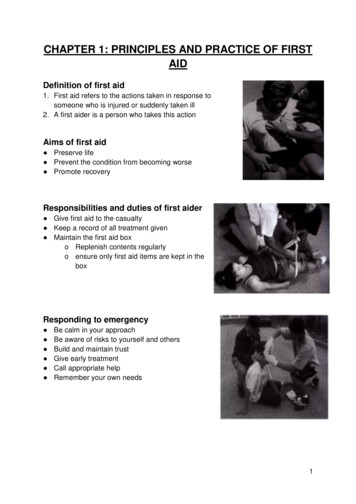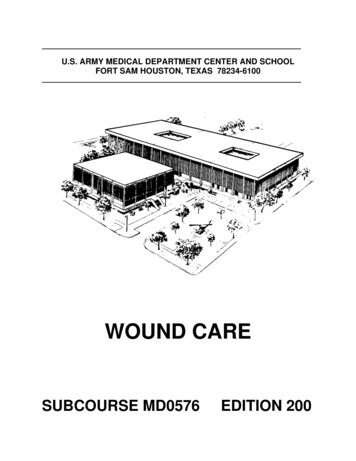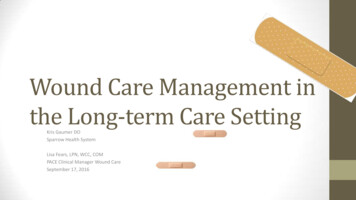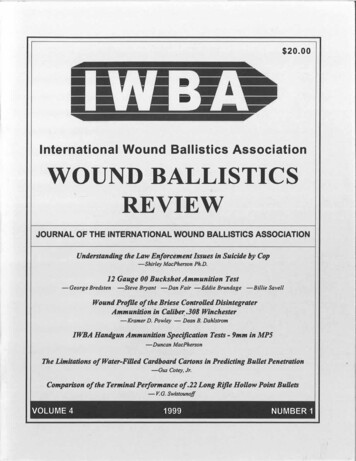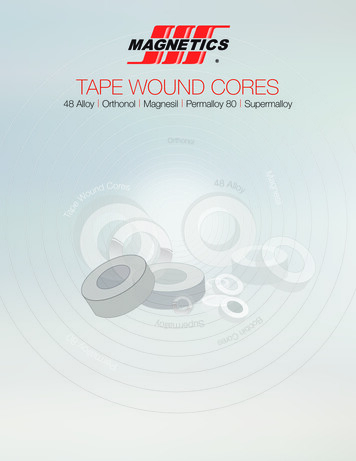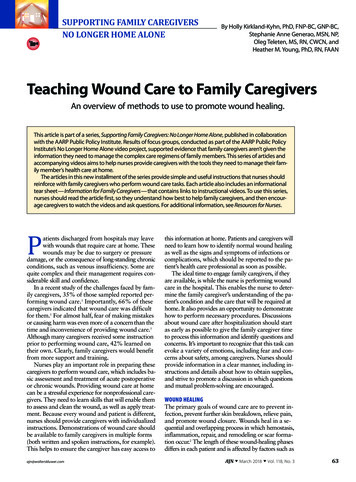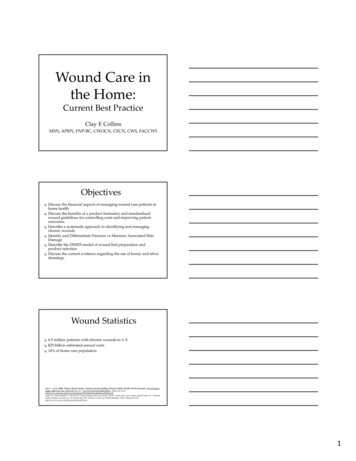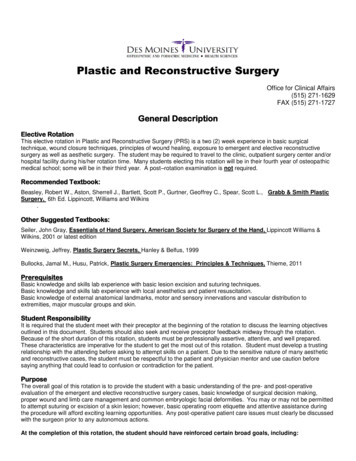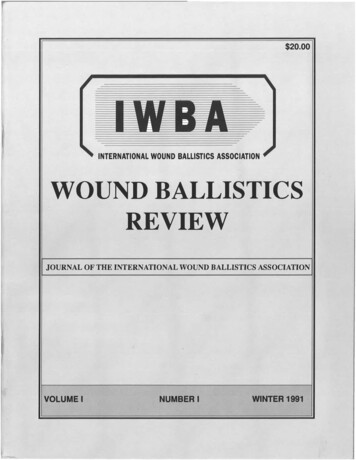
Transcription
20.00IN TERNATIONAL WOUND BALLISTICS ASSOCIATIONWOUND BALLISTICSREVIEWJOURNAL OF THE INTERNATIONAL WOUND BALLISTICS ASSOCIATIONVOLUME INUMBER IWINTER 1991
INTERNATIONAL WOUND BALLISTICS ASSOCIATIONIN TERNATIONAL WOUNDBALLIS TICS ASSOCIATIONSTATEMENT OF PURPOSEThe widespread misinformation and lack ofunderstanding concerning ballistic injury is wellknown to anyone who understands the subject andkeeps up with it's literature.The effects of penetrating projectiles on thebody is of vital concern to trauma surgeons,weapon designers and users, and those involvedwith the forensic aspects of ballistic trauma . Yet,we know of no organization that deals with thesubject exclusively and in depth. Papers contain ing ballistic injury data appear in widely scatteredsources, since many groups include projectileeffects peripherally in their interests. However, ineach source, these comprise a very small percent age of the total papers and most contain numerouserrors. Wound ballistics expertise is sparse, andhuman inertia being what it is, once in print, errorsare likely to go uncorrected. Even when discred ited by letters to the editor, these substandardpapers remain in the literature to mislead theunwary.Effects of the persistently poor understandingof ballistic injury range from substandard gunshotwound treatment to lessened law enforcementeffectiveness.What needs to be done? First, the validliterature needs to be identified. This will give theinterested reader the scientific background mate rial on which to build a solid understanding of thesubject. Next, an ongoing periodic critical reviewWinter/91of the wound ballistics literature needs to beinitiated. Finally, an easily accessible source ofwound ballistics expertise needs to be established.When a need and no ready and recognized sourceof expertise exists, mythology fills the gap.The International Wound Ballistics Associa tion has been founded to fill these needs. TheIWBA is comprised of members possessingverified expertise in one or more aspects of woundballistics and the IWBA publishes a journal, theWound Ballistics Review. By focusing its exper tise upon the literature relating to wound ballistics,the IWBA hopes to stimulate an increased aware ness, among editors, writers, and readers, and tohelp minimize future inaccuracies. Additionally,the International Wound Ballistics Association isprepared to offer its expertise to assist any publi cation concerned with avoiding error and main taining technical accuracy.The IWBA demands skepticism. We areconvinced that by encouraging active questioning,reevaluation, and verification of views, data,cherished beliefs, etc. in the open literature, woundballistics can be delivered from the chaos of its"dark ages" to assume its full potential as a sci ence.Martin L. Fackler, MDPresident, IWBA1
JOURNAL OF THE INTERNATIONAL WOUND BALLISTICS ASSOCIATIONWOUND BALLISTICSTributes & Tragedies . . . . .REVIEWErrors & Omissions . . .Membership Roster. . . . . . . . . . . . . . . . . . . . . . . . . . . . . . . . . . . . . . . . . . . . . . . . . . . . . . . . . . . . . . . . . . . . . . . . . . . 45. . . . . . . .46. . . . . . . . . . . . . 47.JOURNAL OF THE INTERNATIONAL WOUND BALLISTICS ASSOCIATIONNUMBER1VOLUME IWINTER 1991TABLE OF CONTENTSInstructions to AuthorsAssociation News.Reader's Forum . . . . . . . . . . . . . . . . . . . . . . . . . . . . . . . . . . . . . . . . . . . . . . . . . . . . . . . . . . . . . . . . . . . . . . . . . . . . . . . . . . . . . . . . . . . . . . . . . . .4Data Versus Doctrine . . . . . . . . . .Ronald Bellamy, MDBG J.P.L. Breateau, DVMThoracic SurgeonChief, Surgical Research LabSurgeonWashington, DC USAFrench Army Medical Corps.San Francisco, CA USA6Alexander Jason, CPPBeat P. KneubuehlDouglas Lindsey, MD, DrPHDirector, Center forHead of the Scientific StaffProfessor of Surgery, EmeritusBallistics AnalysisDefense Procurement Group 2University of ArizonaPinole, CA USABallistics DivisionPhoenix, Arizona.- Douglas LindseyEditorial:USAThun, Switzerland. . . . . 8.Martin L. Fackler, MDMarseilles, France5ArticlesEditorial:IWBA Charter BoardKarl Sellier, MD, Dipi.-PhysicistThe Twilight Zone of Wound BallisticsProfessor-Alexander JasonInstitute of Forensic MedicineBonn, West GermanyPerformance of the Winchester 9mm 147 Grain Jacketed Hollow PointBullet in Human Tissue and Tissue Simulant.10-Eugene J. WolbergIWBA is a non-profit scientific , educational, and public benefit California corporation awaiting IRS 501 (c)(3) determination. It is comprised of scientists, physicians, criminalists, law enforcement members ,engineers, researchers , and others engaged or interested in the study of wound ballistics .Body Armor Standards: A Review and Analysis . 1 4Editor in Chief: Martin L. Fackler- Alexander Jason- Martin L. FacklerManaging Editor: Alexander JasonJournal Design: A. JasonLiterature Review & CommentThe "Shock Wave" Myth . . . . . . . . . . . . . . . . . .38Subscription InformationU.S. individual and institutional subscriptions : 60 per year. Canadian Subscriptions : 66 per year.Airmail foreign subscriptions : 76 per year.Single copy sales : 20 plus 4 postage and handling for U.S. and 6 for foreign orders .Cat Brain Shots . 40Peer Review:2W here Are The Checks and Balances? . . . . . . . 42. . .Winter/91The WOUND BALLISTICS REVIEW : The Journal of the International Wound Ballistics Association(ISSN 1055-0305) is published quarterly by the IWBA, 2830 D Pinole Valley Rd., #1 1 2, Pinole, CA94564. Telephone (4 15) 234-7335 FAX (4 1 5 ) 724-0733 . Copyright 1 99 1 . All Rights Reserved.Winter/913
JOURNAL OF THE INTERNATIONAL WOUND BALLISTICS A SSOCIATIONWOUND BALLISTICS REVIEWJOURNAL OF THE INTERNATIONAL WOUND BALLISTICS ASSOCIATIONINSTRUCTIONS TO AUTHORSThe Wound Ball istics Review welcomes manuscripts, articles, short notes, and letters to the editor that contribute to thescience of wound ballistics. Publication preference will lean strongly toward pertinent papers with clear practical applications.Association NewsWe invite cogent reviews of articles, books, news items, etc. Our goal is to commend good documentation as well as to point outthe errors in the wound ballistics literature. The Wound Ballistics Review especially requests our readers' help in submittingTechnical Consultant ( 30/yr) is only available byFrom the Presidentinvitation after nomination by two Full Members to thoseshort reviews which correct errors noted in the literature.The review of all manuscripts reporting original work will be open; the names of reviewers will either appear with thepaper when published or will be made available upon request.Articles are accepted only for exclusive publication in IWBA, and when published, the articles and illustrations become theproperty of IWBA. When an article is selected for publication, the author(s) will be required to sign a copyright transmittalwhich also attests to the originality of the material submitted.The experiment described in any paper must represent good scientific method. Complete methodology must be presentedso that the reader can duplicate the experiment exactly.Several of our members have already beguncorrecting errors by writing to editors. BRAVO! Keep itup. Include your IWBA Affiliation in your letter andplease send us an info copy (include a copy of theoriginal article). We will keep them on file and reportprogress in this column.We have a membership of outstanding quality;many are the world's top authority in their area ofspecialization. We encourage our members to sharetheir ideas of how we might better accomplish our goals.Martin L. Fackler, MDPresident, IWBAWork must be based on basic solid understanding of projectile-tissue interaction. Results must be reported completely topermit meaningful comparison. In experimental animal wounds, for example, a clear and thorough quantitative description of theobserved damage must be included, i.e., was the bone fractured? Were major vessels disrupted? How big was the entrance? Thewith specific expertise in related fields who are available toprovide assistance or information of value to our member ship.Associate Membership ( 60/yr) is available toindividuals with an interest in the field. Associate Membersreceive the Wound Ballistics Review and all Associationmailings.Subscriber Membership ( 60/yr) is open to libraries,corporations, organizations, and other entities which wishonly to receive the Wound Ballistics Review: The Journal ofthe IWBA.(All memberships are subject to review and acceptance bythe Membership Board.)Alexander JasonExecutive DirectorMEMBERSHIP: How It Worksexit? What is the appearance of the projectile path (penetration depth, size and morphology of damage to organs, etc.)? Thisinformation is mandatory to allow meaningful correlation of the wound reported to military as well as civilian wounds.The entire paper must be expressed in language understandable to the layman.SUBMISSION INSTRUCTIONSI. If submitting a letter or review which refutes or points out errors in another work, please provide the address of thesource (please include a copy of the article reviewed--these will be returned if requested); IWBA will notify the editor of thesource pending correction inviting a rebuttal to be published with the review if one is submitted.2. In submitting original work, the manuscript and one copy is requested ; one set of glossy illustrations are required.Corresponding author must be clearly identified on the title page with address and telephone number. Manuscript must bedouble-spaced with ample margins (at least one inch on all sides) on standard (8 1/2" x 11 ") paper. NOTE: THE PREFERREDMANUSCRIPT FORM IS THE 5 1/4" (1.2 Meg or 360K), or 3 1/2" (1.44 Meg or 760K) PC FLOPPY DISK WITH A PAPERCOPY. All major PC word processors are acceptable but Wordperfect 5.0 or 5.1 is preferred.3. References are to be numbered sequentially within the text and appear in the order cited at the conclusion of the article.Examples:Book- Black KE, Jederberg WW. Athymic nude mice and human skin grafting. Maibach HI, Lowe JN, eds.Models in Dermatology:vol 1. Basel: S Karger, 1984;226-239.Article in periodical- Fackler ML, Surinchak JS, Malinowski JA, et a!. Bullet fragmentation: A major c ause oftissue disruption. J Trauma 1984;24:263-266.Several people have asked how they can benominated as an FM or TC. We suggest that theybecome Associate Members and then contribute articlesto our Journal and/or demonstrate their knowledge andvalue to the Association in other ways. It is our hopethat FM or TC status in the IWBA will have someintrinsic value by virtue of the caliber of the expertise,abilities, knowledge, and accomplishments of ourmembers. We are seeking quality; not quantity in ourmemberships.4. Legends for all illustrations should be listed in order, double spaced.The membership types are:Full Membership ( 40/yr) is only available to those5. An abstract of 150 words or less should preceed the text.actively engaged in wound ballistics research and/or to those6. The editors reserve the right to require a CV from any author who is not a member or technical consultant of the IWBA andwhose previous works are not known to them.4The IWBA is unlike many other associations inthat our Full Member and Technical Consultant mem berships are only available by nomination and invitation.There is no automatic qualification for Full Member orTechnical Consultant status. For example, while manyFull Members are physicians, just having a medicaldegree is not qualification for Full Membership andwhile many Technical Consultants are law enforcementmembers, all police officers are not automatic TC's. Theoverall primary consideration in our nominating FM'sand TC's is that they possess a solid understanding ofelementary wound ballistics.who have made substantial contributions to the subject. FullMembership status is by invitation after nomination by twoFull Members.Winter/91Winter I 91Bad Body Armor?We have recently received several inquiriesfrom law enforcement officials concerned aboutnational news media (CBS, Associated Press, etc .)reports and a FBI "bulletin" stating that twomanufacturers of soft body armor (Second Chanceand American Body Armor) had made protectivevests which were in some way "substandard" ordeficient. While we are not able to discuss theallegations in this issue, we are fully aware of thedetails of the controversy and those concernedshould be aware that it is our opinion that theallegations are without merit and should be disre garded. To those in law enforcement wearing vestsmade by either manufacturer we c an state that ifyou had confidence in your vest before the newsreports, you should continue to maintain thatconfidence.The source of the spurious allegations is theNational Institute of Justice (NIJ) and are political,not scientific in nature. The real problem is notwith the maligned vests but with the incompetenceof the NIJ. We may have more on this matter inthe next issue. Those interested in the subjectshould read the "Body Armor Standards : A Re view and Analysis" article starting on page 14.AJMLF5
WOUND BALLISTICS REVIEWJOURNAL OF THE INTERNATIONAL WOUND BALLISTICS ASSOCIATIONReader's ForutnTo The Editors:I am writing in the hope that your associa tion will be able to help our Unit. I am currentlyserving in a newly established Unit within ourPolice Department. The Victoria Police Depart ment has a strength of over 9000 Police person nel.The Unit is called Firearm s OperationalSurvival Training Unit (F.O.S.T. U . ) and hasb een set up as a response to a number of factors. The lack of Training in Officer S urvival The need to keep abreast of currenttraining trends Nationally and InternationallyThe need to research Operational Inci dents ie, shooting incidents etc. This is a small insight into the unit and whyit is has been established. The last area men tioned is where we are having a great deal ofproblems obtaining inform ation. Our unitattends scenes of major violence, particularlythose involving Police shooting O ffenders andbeing shot at.JOURNAL OF THE INTERNATIONAL WOUND BALLISTICS ASSOCIATIONA ssociation. The questions you pose are ex tremely pertinent and need good documentedanswers.shooting incidents. The operation involvedS .O.G. entry to search for a violent offenderwho had been involved in a shooting. The entryteam encountered the offender with a firearm .He w as shot a number of times b y 9mm roundsand by 1 2 gauge SG shotgun rounds. Duringthis whole inci dent the offender remained athreat and struggled with the Police after beingshot.Q uestions have been asked "How can aperson continue to be a threat after being shot som any times?" We are in the position of requir ing information and documented cases of simi lar incidents where offenders have been shot andcontinue to b e a threat to Police.I feel your A ssociation could providevaluable information to out unit and assist us inour enquires. If we can b ecome members ofyour association please provide details.Bob Carter, SergeantFirearms Operational Survival Training UnitC/- Victoria Police AcademyViewMount Rood Glen WaverleyVictoria Australia 3 1 50A t the present time our state Government isconducting an inquest into Police Shootingsdating b ack to 1 98 5 . Questions are being askedconcerning the number of shots fired at offend ers and whether they are excessive.Dear Sergeant Carter,As a result of a recent shooting incidentinvolving our Special Operations Group (S.O.G)equivalent to your S .W.A .T. team s our unit hasbeen required to provide details concerningThe reasons for setting up the VictoriaPolice Department ' s Firearm s OperationalS urvival Training Unit coincide closely with thegoals of the International Wound B allistics6WOUND BALLISTICS REVIEWResponse:Winter I 91I have testified in numerous court cases andinquests defending law enforcement officersagainst allegations of excessive use of force. Insome cases this translates into someone actuallyb elieving that too m any shots were fired - aneasy judgment to m ake by those who were notengaged in the gunfight- b ut, m ore com m only, it is simply an attempt to m ake m oneyfrom a civil lawsuit by drumming up publicemotion over a c ase. In a Canadian case in1 989, thirteen 9 mm b ody hits were clearlyjustified; in a more recent California case, three9 mm shots in the head were j ustified.LaGarde recounts, in the enclosed pagesfrom Gunshot Inj uries (Wm . Wood & Co.,1 9 1 6) , the charge of a M oro w arrior who w asalive and presumably still a threat after ten bodyhits from the 30-40 Krag service rifle. Alsoshown in these pages is a survivor of three chestshots and one in the arm from the .38 Coltrevolver. A dditionally, I have enclosed a copyof a letter to the Los A ngeles Police FirearmsUnit which contains eight historical referencesto m any head shots that did not result in death(or even unconsciousness in some cases).In m y files, I have an autopsy report (withX-rays, police and crime lab report) of a case inwhich 27 hits b y 9 mm 1 1 5 grain Silvertip wereneeded to incapacitate a determ ined person.These b ullets, which expand too m uch and lackadequate penetration even from a handgun (seeenclosed copy of the FBI 1 9 8 7 Wound B allisticsWorkshop) , were fired from a submachine gun.The additional velocity caused them to fragmentin the superficial tissues and they just were notreaching vital organs.In order to make any meaningful commenton the recent shooting involving your SpecialOperations Group I will need a copy of theautopsy report (including copies of pertinent X-Winter I 91rays), the police report and the crime lab reporton the recovered b ullets. If you send these I w illbe happy to provide you with an analysis of theincident including answers to your questions.We w ill then add the inform ation to the Interna tional Wound B allistics A ssociation files so thatit can be m ade available to other law enforce ment agencies as needed.Disbelief that a person can continue to be athreat after absorb ing m any shots results fromwidespread pub lic ignorance on b ullet effects.This ignorance is fostered by the entertainmentand the news media' s constant exaggerationsand preference for the spectacular (whether itbears any relation to the truth appears to be ofno concern) . Collecting and correlating b othrecent and historical documented cases to com bat misinform ation is a m aj or goal of our newlyformed organization.The good news is that over the past fewyears more law enforcement groups are electingto fight unjust allegations and go to court whenneeded rather than caving in to pressure fromthe press and other sources - and they arew inning. A s w ord gets around that logic andrealistic analysis are defeating the typical non sensical emotional appeals in court I suspect thatwe w ill see a decrease in these lawsuits. Thenlaw enforcement can get b ack to their job ratherthan having their resources bled by ill-conceivedand opportunistic accusations. A lso, thenofficers may b ecome less hesitant about puttingthe number of shots into their adversary neededto end the threat- however m any shots thatmay be! (OFFICER S URVIVAL LESSONONE)The question of how many times a criminal may beshot has drawn much interest from the lawenforcement community and may be the subj ect of afull article in our next issue -Ed.7
EditorialWOUND BALLISTICS REVIEWJOURNAL OF THE INTERNATIONAL WOUND BALLISTICS ASSOCIATIONWOUND BALLISI C S R E VIEW --:T -- :. .:.:: - -.JOURNAL OF THE INTERNATIONAL WOUND BALLISTICS ASSOCIATION(Take your choice:)Editorials Data Versus DoctrineDouglas LindseyThirty years ago Janice Mendelson and I dida study of the course and outcome of woundsproduced by a number of commonly used bulletsranging in velocity from 605 to 2844 feet persecond ( 1 96 1 ). Doing the study was straightfor ward wound ballistic research: lasso the goats inthe pen; bring them into the laboratory for anes thesia, positioning, shooting, and measurement ofvelocity; return the goats to the pen.Getting the study published was a drawn-out,bitter, recriminative struggle with the higherechelons. The data were in conflict with doctrine:all of the wounds--even at the highest velocity- healed without evidence of muscle necrosis orinfection. The last sentence of our paper was, "Itseems reasonable to conclude that . . . the amountof debridement required for a bullet wound shoulddepend more on the damage inflicted than on thenature of the missile." This statement is a forerun ner of "Treat the wound, not the weapon" but it iscouched in restrained, modest, and less inflamma tory terms. Nevertheless it was anathema in thePentagon.Other studies have confirmed our findings.Tissue which is stretched and contused by thetemporary cavity produced by passage of a missileis "non-viable" only if it is excised and discarded;if left alone it heals. Finally, after the passage ofnearly thirty years, the Department of Defense hasrecognized this fact, but many authors and practi tioners of the surgery of trauma have not.8 Why is the doctrine so impervious to therevision demanded by clear evidence? There aremany factors involved. The momentum of longstanding practice. Reluctance to swallow the pillof retraction. Public and professional fascinationwith "assault rifles" and "high velocity." But ifrevision or reversal is not possible, perhaps we canmake do with erosion: patient and repetitiveimpact of data against doctrine. I welcome theadvent of this Journal, a critical review of woundballistics.Douglas Lindsey is Professor of Surgery, Emeritusat the University of Arizona and an IWBA foundingmember.The "Twilight Zone" of WoundBallisticsAlexander JasonThere is one common misconception whichhas done much to confuse and mislead peopleabout wound ballistics: the belief that there issome mysterious mechanism by which a bullet cancause sudden incapacitation without disruption ofthe central nervous system or rapid blood loss.Rod Serling might have introduced it this way:"There is another method of incapacitation beyondthat which is known to man. It is in the middleground between light and shadow, between sci ence and superstition and it lies between the pit ofman ' s ignorance and the summit of his imagina tion. It is a mechanism we call:"Winter I 91Editorial Stopping powerHydrostatic shockRelative Incapacitation IndexRemote effectsKinetic energy transferTemporary cavitation"Chi" vibrationsReticular activating system shutdownShocking powerWhile the above exotic, mysterious, andalways ambiguous definitions have a powerfulattraction to many people, the reality of incapacita tion is much more banal. The only reliable mecha nisms by which bullets can cause rapid incapacita tion are:1 . The bullet either struck and damaged thecentral nervous system, the heart, a major vessel,organ or bone rendering the suspect physicallyincapable of continuing or;2. The person being shot consciously andvoluntarily decided to cease his assault or escape.These are not theories but clear and easilycomprehensible facts yet many people who shouldknow better appear to find them excessivelysimple. They prefer to search for more complexand enchanting mechanisms to explain how bulletswork.One of the roots of this search for "magicbullets" nonsense is found within the Orientalmartial arts world. There are many myths withinKarate, Aikido, Kung-Fu and other such disci plines suggesting that there is a certain "force" ormethod of "focusing energy" upon an opponentwhich can cause his internal organs to "melt" orsimply to cause immediate unconsciousness. Thetalk is that there are (or were) various old martialarts "masters" able to incapacitate or even killopponents with only the touch of finger or by asingle punch to the midsection. While neverscientifically defined, these "powers" are usuallyvaguely described as techniques causing certaindestructive "vibrations" within the body.Winter I 91Contributing to belief in such phenomena aremartial arts "demonstrations" during which a self proclaimed "master" will announce to his audienceof True Believers that he will demonstrate his su perior powers by simply touching someone on thechest and causing him to immediately fall uncon scious. An eager volunteer (usually an adoringstudent) will be chosen and after an impressivefanfare of deep breathing, contemplation, andperhaps a shout by the "master," the volunteerwill, of course, fall over on cue when touched. Thereal cause is self-suggestion or simply a desire tosave the guru from public embarrassment. Theevent is much like a faith healing; although the"healed" person may not have felt his canceroustumor "melt away" as proclaimed, he's not goingto admit it among thousands of cheering believers.The unquestioning, sympathetic spectators at suchevents come away with their beliefs stronglyreinforced.The martial arts deadly "vibrations" mythshave worked their way into wound ballisticsbecause many in law enforcement and amongthose interested in firearms often also have aninterest in the martial arts and most have heard ofthese mysterious "powers." Their logic suggeststhat if incapacitation can be achieved by means ofa simple touch or punch then it must follow that abullet' s "punch" into a human body must becapable of producing those same "vibrations" (orwhatever) and therefore sudden incapacitation.Those who attempt to rate bullets by "one stop-shots" or by how quickly shot animals col lapse contribute to this wound ballistics mysticismyet some of these people do so unintentionally. Itis often the result of their failure to have "checkedtheir premises;" to examine their own fundamentalassumptions. While there is certainly a need forscientific thought and analysis in the martial artsworld, we have enough mythology and nonsensewithin our own world of wound ballistics and it isnot my intention for us to branch out into otherfields. But I hope that this Journal will encourageus all to analyze and question our assumptions; tocontinually check our premises.9
WOUND BALLISTICS REVIEWJOURNAL OF THE INTERNATIONAL WOUND BALLISTICS ASSOCIATIONWOUND BALLISTICS REVIEWJOURNAL OF THE INTERNATIONAL WOUND BALLISTICS ASSOCIATIONPerformance of the Winchester 9mm 147 GrainSubsonic Jacketed Hollow Point Bullet in HumanMeasurements From Human Shootings withWinchester Subsonic 147 Grain JHP BulletTissue and Tissue SimulantEugene J. WolbergTwenty-seven shootings were reviewed. Thepenetration depth of the 147 grain WinchesterSubsonic JHP bullet in living human tissue wasmeasured at autopsy, and the bullet's expansionwas measured from the recovered bullets.These were compared to the bullet's perfor mance in 10% ordnance gelatin shot at 4 de grees Centigrade. A close correlation wasfound.In 1 987 the San Diego Police Departmentadopted the 9mm Parabellum 147 grain Subsonicjacketed hollow point (JHP) Winchester bullet forits duty pistols. The adoption was based on therecognition that adequate penetration potential isof paramount importance to bullet performance.Shots with this bullet into 1 0% ordnance gelatinshot at 4 degrees C confirmed that it reliably andconsistently penetrated over 1 2 inches.Recognizing that the human torso containsdifferent organs of varying densities, while gelatintissue simulant is a homogeneous material, it wasdecided to collect results from shootings with thenewly adopted 147 grain 9mm bullet and comparethem with results from the shots into the 10%gelatin. Bullet penetration depths were measuredat autopsies resulting from officer involvedshootings. Ordinarily, measured penetration depthfigures are not found on autopsy reports. How ever, for this study our medical examiner agreed tomeasure bullet penetration depths and includethem in the autopsy reports. Only shots into thetorso that remained in the body for their entirepenetration depth were included in this study.Measurements of bullet expanded diameter and itsremaining length were taken directly from thebullets recovered at autopsy. These results were10then compared with results from the 1 0% ordnancegelatin in order to assess the accuracy of this tissuesimulant' s predictive accuracy.SHOTS INTO ORDNANCE GELATINThe gelatin was prepared using the method ofthe Letterman Army Institute of Research (1).After each shot, the bullet' s penetration depth inthe gelatin, its expanded diameter (average of thelargest and smallest diameter - most expandedbullets are not exactly round), and its length weremeasured. An expansion ratio was derived foreach bullet by dividing its expanded diameter (ED)by its remaining length (RL).The 147 grain Winchester Subsonic JHPbullet had an average penetration depth in the 1 0%gelatin of approximately 13 inches with a range of1 2 to 14 inches. The bullet 's expansion ratioapproximated 1 .20. It's average velocity (mea sured with an Ohler Model 33 chronograph) was950 feet per second. These results were obtainedfrom 20 shots, from two different lots of ammuni tion.SHOTS FROM HUMAN AUTOPSIESThe following chart lists information re trieved from the autopsy reports and crime labora tory investigations and observations. It should benoted that all head wounds, and bone hits wereeliminated; this study deals only with shots thatpenetrated soft tissue of the torso and did not hitbone.BULLET DATARATIOED .5351.141.FinalWeight142 g
Performance of the Winchester 9mm 147 Grain Jacketed Hollow Point Bullet in Human Tissue and Tissue Simulant . 10 -Eugene J. Wolberg Body Armor Standards: A Review and Analysis . 14 -Alexander J
